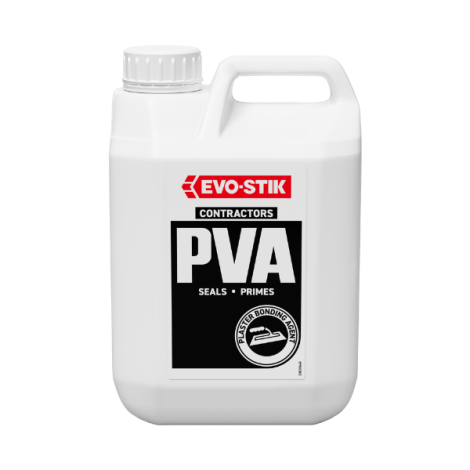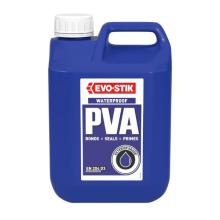Contractors PVA

Features and benefits


EVO-STIK Contractors PVA is a plaster bonding agent that primes and seals porous surfaces to create a better base for plastering. The plastering PVA prepares the substrate by reducing suction and improving adhesion, helping plaster bond reliably from the first coat.
Formulated with plastering work in mind, this bonding agent for plaster helps regulate porosity of the substrate to prevent patchy drying and reduce the risk of weak adhesion or cracking. Its sealing action also reduces dust and stabilises surfaces, supporting a more consistent finish on interior walls and ceilings.
The versatile formulation can be diluted for priming or used neat as a tack coat when bonding new plaster to both porous and non-porous surfaces. Suitable for a wide range of common building materials, this PVA for plastering adapts well to the varied surfaces found on mixed-construction projects.
Supplied in a practical 5kg polyjerry, the plastering PVA is ideal for frequent use, reducing the number of containers needed on busy jobs.
Suitable materials: Bonds a wide range of materials provided one of the surfaces is porous, including timber, plywood, blockboard, chipboard, fibreboard, expanded polystyrene, polyurethane foam, insulating board, brick, concrete, plaster, stone and slate.
Sizes: 5kg.
Coverage: 6-14m² per litre depending on application thickness and substrate.
HOW TO USE
PREPARATION
1. Surfaces must be sound, clean and free from contaminants such as dust, oil, grease and any loose material.
2. Shake the Contractors PVA well before use.
3. The plastering PVA can be applied by brush or roller.
APPLICATION
To prime porous surfaces before plastering:
4. Apply a mixture of one part Contractors PVA diluted with three parts clean water. Allow this primer coat to dry before continuing.
To bond new plaster to porous surfaces:
5. Prime as above, allow to dry, then apply a neat coat of Contractors PVA. Apply plaster while the PVA remains tacky.
To bond new plaster to non-porous surfaces:
6. Apply an undiluted coat of Contractors PVA before plastering, and apply plaster while the film is still tacky.
Good to know: Learn how to use EVO-STIK Contractors PVA for priming porous surfaces and bonding new plaster to both porous and non-porous backgrounds by referring to the Technical Data Sheet.

HOW TO REMOVE
7. Clean tools and equipment with warm soapy water immediately after use.
FAQs
EVO-STIK Contractors PVA is used to prepare porous surfaces for plastering by reducing suction, sealing dust and improving adhesion. It can also be applied neat as a tack coat to help new plaster bond to a range of porous and non-porous backgrounds.
Only if the paint is firmly bonded. EVO-STIK Contractors PVA should never be applied over loose, flaking or poorly adhered paint, as this can prevent the new plaster from bonding properly. If the paint is sound, the wall can be primed with a diluted PVA mix and then coated with a neat layer that is plastered while still tacky. If the paint is unstable, it must be removed first to expose a suitable surface.
For porous surfaces, the typical approach is one diluted coat of EVO-STIK Contractors PVA to prime the surface and one neat coat applied just before plastering. The neat coat must remain tacky when the plaster goes on. Non-porous surfaces usually only need an undiluted coat used as a tack coat.
The diluted primer coat of EVO-STIK Contractors PVA should be allowed to dry completely. The neat coat used as a bonding layer must not dry - it should be plastered onto while still tacky. Open time can vary depending on temperature, humidity and the surface, but typically ranges from around 5 to 10 minutes.
On porous backgrounds, plaster can dry too quickly and unevenly, weakening adhesion and increasing the risk of cracking. EVO-STIK Contractors PVA helps regulate suction and stabilise dusty surfaces, creating a more controlled, consistent base for the plaster. Without it, the plaster may not bond as reliably, especially on highly absorbent substrates.




